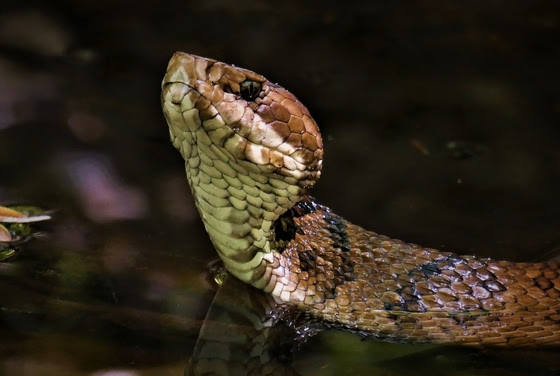Myths about Cottonmouths
COTTONMOUTH VIDEO UNDERCUTS MYTH

Cottonmouth in a south Georgia stream (Matt Moore)
By MATT MOORE
Judging by comments at public education programs I’ve done, cottonmouths are the most misunderstood and maligned of Georgia's six native species of venomous snakes.
I have worked in close proximity with many cottonmouths (aka water moccasins) over the years and I encounter dozens each year in the south Georgia swamps where I conduct wetland field work. Yet I’ve never had a cottonmouth chase me – a prominent myth concerning this species – or try to bite me.
Earlier this month while wading in a narrow, shallow stream in a south Georgia swamp, I met a large eastern cottonmouth – approximately 4 feet long – swimming upstream. My video of the encounter shows the snake's initial curiosity as it tries to figure out what this large obstruction in its path is.
After deciding that I’m an animate object and thus a potential predator, the snake decides to avoid the threat by swimming around me.
Later, I had to walk back past the snake to get to my car (walking in water where you can see your feet was safer here because the forest is thick with knee-high vegetation). As seen in this segment, the cottonmouth is in a defensive coil. But though alarmed, it still only cowers against the stream bank as I carefully pass by.
I do believe people have had snakes, some of which may have been cottonmouths, come toward them in the wild. As the video shows, so have I. But it’s been my experience this invariably happens when the snake is either not aware of my presence until it is very near or it’s fleeing toward refuge, such as a hole in the ground of body of water, and I happen to be between the snake and the refuge.
I think both encounters filmed here (video 1 and video 2) underscore those points and hopefully help dispel the cottonmouth’s unfounded reputation as aggressive.
Matt Moore, of Statesboro, works as a field technician with The Orianne Societyand DNR’s Nongame Conservation Section. His work and the frequent contact it involves with snakes requires training, experience and caution.
If you encounter a snake, DNR's recommendation is that you try to identify it only from a distance and give the snake the space it needs.
ALSO …
- How close? In the first video, the cottonmouth approaches within about 18 inches of Matt Moore's foot. Although close, Matt said he was not in danger of being bitten, or violating safety protocol, because the snake was stretched out.
- Quotable: “There’s more footage of UFOs and Bigfoot than of cottonmouths chasing somebody.” -- Matt, on the lack of documentation for cottonmouth “attacks”
- Footwear: If you’re wondering, Matt wears lightweight wading shoes because they are more functional and durable than snake boots for the extensive wading required for his wildlife surveys. To avoid surprises, he said he lets "his eyes go to a place” before his feet or hands do.
- Learn more: Brochures including “Is It a Water Moccasin?” and “Venomous Snakes of Georgia,” plus other info, are available at www.georgiawildlife.com. Photos of native snake species are on Flickr.



Comments
Post a Comment